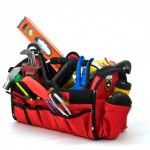
On a number of different posts here, I’ve talked about paint tools you need to own: certain brushes, certain rollers and so on. However, a must-have tool for every do-it-yourself painter or professional contractor is something that’s not as obvious: a wet/dry vacuum.
Believe it or not, this can be one of the most helpful, time-saving (and potentially life-saving) tools in your arsenal. See, when people paint inside their homes, one of the most common occurrences involves a ladder, a paint tray and the innate human desire to take short-cuts. Typically, it works like this: you’ve got your paint tray hooked to your ladder and you’re happily working your way around your room. At some point, you decide to move the ladder and, because you’re almost at the end of your project, you decide just to pull the ladder–after all, if you do it carefully, there’ll be no problem, right? Well, normally there isn’t. But every now and then, the ladder hits something and before you know it, the paint tray goes over the edge, hits your carpet (it always misses the dropcloth!) and you’ve got a mess.
And that’s why having a shop-vac on hand is such a life-saver: it gives you your best chance of dealing with the mess and preventing it from becoming a disaster.
However, having the right tool on hand is one thing. Knowing how to use it is another. So, with that in mind, here’s how you go about using your shop-vac to clean up a LATEX paint spill:
DON’T PANIC
The first thing you need to do–as is the case with any emergency–is to resist the natural urge to freak out. Yes, you spilled paint on the new carpet. Yes, it’s a mess. Yes, you’ll probably be in big trouble with someone else in your home. But freaking out and running around in circles isn’t going to help you save your neck. Calm, cool thinking wins out every time. So stay calm. That’s step one.
COLLECT YOUR TOOLS
Calmly (but quickly) grab a bucket of water, some old rags and either a couple wide (6″-10″) putty knives or some scraps of cardboard.
REMOVE PAINT FROM THE SURFACE
Start your clean up by removing as much paint as you can from the surface. You can do this by scraping it (carefully) off with the wide putty knives or the ripped up scraps of cardboard. Use either of these items to scoop as much paint off the carpet as possible and return it to the paint tray–NOT THE BUCKET (since you don’t want to add any contaminant to your paint bucket).
BRING ON THE DAMP RAGS
After the excess paint has been removed and you’re left with the paint that’s soaked into the carpet, bring out your damp rags. Use these to sponge the spot and remove as much of that soaked-in paint as possible.
BREAK OUT THE WET/DRY VAC
After you’ve done all of this, it’s time for the WET/DRY vacuum. Hit the spot carefully and pull up as much paint as possible. Introduce more clean water, work it around with your fingers or hand and then vacuum it back up. Do this again and again and again until the paint has been completely removed. Don’t quit with this step until you feel you’ve pulled out as much of the paint from the spill as you’re going to get. Once you let it dry, you’re done–you can’t go back for a second try tomorrow night.
DRY THE CARPET WELL
Once the paint’s removed, carefully blot the wet area with dry towels (don’t scrub the spot with your towels as you can damage your carpet that way.) Blot the area, removing excess moisture and then put a fan on the area and allow it to thoroughly dry.
If you follow these steps carefully and thoroughly, in about 24 hours, the spot should show no signs at all of the near tragedy that happened there. And all because you had a wet/dry vacuum in your tool belt!
 Green lawns are something we all strive for. A sprinkler system may help. But for those with an older system, it can be very complicated.
Aaron Katerberg from Grapids Irrigation joins us in the studio once again. This time he tells us all about the newest technology in sprinkler systems. The best news is, many things can be retrofitted to older systems.
Green lawns are something we all strive for. A sprinkler system may help. But for those with an older system, it can be very complicated.
Aaron Katerberg from Grapids Irrigation joins us in the studio once again. This time he tells us all about the newest technology in sprinkler systems. The best news is, many things can be retrofitted to older systems. 




 ROLLER FRAMES. We recommend that you have at least one 9" roller frame and one 4" roller frame in your kit. Most folks already have one or more of these, but if you don't, then you'll want to make sure you pick up one or more. Having a 9" roller frame is great for those larger areas you need to paint. And the 4" frame is perfect for small jobs and touch-ups.
ROLLER FRAMES. We recommend that you have at least one 9" roller frame and one 4" roller frame in your kit. Most folks already have one or more of these, but if you don't, then you'll want to make sure you pick up one or more. Having a 9" roller frame is great for those larger areas you need to paint. And the 4" frame is perfect for small jobs and touch-ups. ROLLER COVERS. Well, it doesn't take a rocket scientist to see that your roller frames are only going to be useful if you've got a couple covers to go on them. At RepcoLite, we recommend that you have at least one 9" cover and one 4" cover on hand at all times. And, if at all possible, make sure they're new. Used roller covers can work out OK for priming, but if you're trying to do any touch-ups or repainting, you'll want a brand new roller cover.
ROLLER COVERS. Well, it doesn't take a rocket scientist to see that your roller frames are only going to be useful if you've got a couple covers to go on them. At RepcoLite, we recommend that you have at least one 9" cover and one 4" cover on hand at all times. And, if at all possible, make sure they're new. Used roller covers can work out OK for priming, but if you're trying to do any touch-ups or repainting, you'll want a brand new roller cover. 9" ROLLER TRAYS. Most folks have a roller tray or two sitting around in their basement or their work room or possibly even their garage. However, if you're not one of those people, then get your hands on one. You could purchase a standard metal tray (which works well with cheap, disposable tray liners) or you could opt for a cheaper plastic tray like the one pictured at the left.
9" ROLLER TRAYS. Most folks have a roller tray or two sitting around in their basement or their work room or possibly even their garage. However, if you're not one of those people, then get your hands on one. You could purchase a standard metal tray (which works well with cheap, disposable tray liners) or you could opt for a cheaper plastic tray like the one pictured at the left. 4" ROLLER TRAY. Besides making sure you have a standard 9" roller tray on hand, you should also buy a handful of disposable 4" trays as well. These 4" trays are great for all sorts of little touch-up work and other small projects. They clean up well and will easily last you through 3 or more paint jobs. Best of all, they usually retail for just over $1.00.
4" ROLLER TRAY. Besides making sure you have a standard 9" roller tray on hand, you should also buy a handful of disposable 4" trays as well. These 4" trays are great for all sorts of little touch-up work and other small projects. They clean up well and will easily last you through 3 or more paint jobs. Best of all, they usually retail for just over $1.00. THE CHINEX EXCALIBUR BRUSH from CORONA. OK, this is the one area where we'd recommend that you splurge a little. This brush from Corona is comprised of special filaments that are chemically engineered to release latex paints. This means a couple of things. First, the brush will apply latex paints remarkably well. Secondly (and more importantly, in my book), this means the brush will clean up easily. Literally, you can swirl this brush around in a bucket of water for about 30 seconds and then run it under a tap for 10-15 seconds more and it will be perfectly clean. That's why we recommend it for your "Emergency Kit". The ease with which it cleans up makes it less of a pain for you to switch colors and accomplish multiple little touch-ups quickly and easily.
THE CHINEX EXCALIBUR BRUSH from CORONA. OK, this is the one area where we'd recommend that you splurge a little. This brush from Corona is comprised of special filaments that are chemically engineered to release latex paints. This means a couple of things. First, the brush will apply latex paints remarkably well. Secondly (and more importantly, in my book), this means the brush will clean up easily. Literally, you can swirl this brush around in a bucket of water for about 30 seconds and then run it under a tap for 10-15 seconds more and it will be perfectly clean. That's why we recommend it for your "Emergency Kit". The ease with which it cleans up makes it less of a pain for you to switch colors and accomplish multiple little touch-ups quickly and easily. SPACKLING COMPOUND. Another key component for your "Home Repair Emergency Kit" is an 8 oz containter of White Lightning Lightweight Spackling Compound. It's easy to work with, it dries quickly and resists shrinking and, best of all, it's a breeze to sand! Having a tub of this stuff on hand at all times means you're always ready to patch a ding in your drywall or fill nail holes.
SPACKLING COMPOUND. Another key component for your "Home Repair Emergency Kit" is an 8 oz containter of White Lightning Lightweight Spackling Compound. It's easy to work with, it dries quickly and resists shrinking and, best of all, it's a breeze to sand! Having a tub of this stuff on hand at all times means you're always ready to patch a ding in your drywall or fill nail holes. PUTTY KNIVES. If you're going to stock up on a little bit of spackling compound, then you better get a few putty knives to go with it. Now, if you want some high-quality knives, you can buy them at RepcoLite for about $5.00 - $7.00 or so. But if you want something cheaper for your "Emergency Kit", look into the plastic knives we stock. Oh, they're not going to last forever, but if you're just filling a few holes or doing a little puttying, they'll be fine. You can purchase them in 1", 2" and 3" sizes--each one less than $1.00.
PUTTY KNIVES. If you're going to stock up on a little bit of spackling compound, then you better get a few putty knives to go with it. Now, if you want some high-quality knives, you can buy them at RepcoLite for about $5.00 - $7.00 or so. But if you want something cheaper for your "Emergency Kit", look into the plastic knives we stock. Oh, they're not going to last forever, but if you're just filling a few holes or doing a little puttying, they'll be fine. You can purchase them in 1", 2" and 3" sizes--each one less than $1.00. 6" and 10" JOINT KNIVES. However, though plastic knives will work out alright for most patching work, you'll probably want to invest in one or two drywall joint knives. These are 6" or 10" knives that run between $4.50 and $7.25 and they're very handy to have if you're filling any large areas--a definite must-have in your kit.
6" and 10" JOINT KNIVES. However, though plastic knives will work out alright for most patching work, you'll probably want to invest in one or two drywall joint knives. These are 6" or 10" knives that run between $4.50 and $7.25 and they're very handy to have if you're filling any large areas--a definite must-have in your kit. TAPE. Always have a roll of safe-release painter's blue tape from 3M around. Sure, you could purchase cheaper rolls of tape, but the safe-release tape is nice because it can be used on so many different surfaces. It's the only tape I know of that can perform well on walls, trim, freshly painted areas, and wallpaper. Regular tape is limited as to where it can be used, but the safe-release 3M tape can be used in almost any situation you encounter. And, as an added benefit, this tape offers remarkably crisp cut-in lines.
TAPE. Always have a roll of safe-release painter's blue tape from 3M around. Sure, you could purchase cheaper rolls of tape, but the safe-release tape is nice because it can be used on so many different surfaces. It's the only tape I know of that can perform well on walls, trim, freshly painted areas, and wallpaper. Regular tape is limited as to where it can be used, but the safe-release 3M tape can be used in almost any situation you encounter. And, as an added benefit, this tape offers remarkably crisp cut-in lines.  DROPCLOTHS. Besides masking tape, we'd also recommend that you purchase a 12' x 15' or so plastic dropcloth. These aren't expensive and they can be used for any number of little jobs that come up: from protecting your floors while you're painting to protecting your furniture from dust if you're doing any remodeling.
DROPCLOTHS. Besides masking tape, we'd also recommend that you purchase a 12' x 15' or so plastic dropcloth. These aren't expensive and they can be used for any number of little jobs that come up: from protecting your floors while you're painting to protecting your furniture from dust if you're doing any remodeling. SANDPAPER. One of the easiest tools to overlook is sandpaper, yet it's something that we used in many typical home repair projects. Whether you're repainting, patching walls, or painting furniture, sandpaper plays a critical role in the process. So get your hands on six to ten sheets of 220 grit, 150 grit, and 120 grit paper. Those are the most commonly used grits and having a stock of each one on hand will help you out immensely.
SANDPAPER. One of the easiest tools to overlook is sandpaper, yet it's something that we used in many typical home repair projects. Whether you're repainting, patching walls, or painting furniture, sandpaper plays a critical role in the process. So get your hands on six to ten sheets of 220 grit, 150 grit, and 120 grit paper. Those are the most commonly used grits and having a stock of each one on hand will help you out immensely.